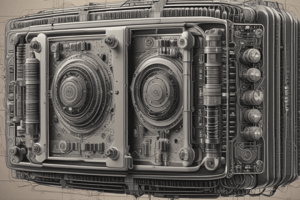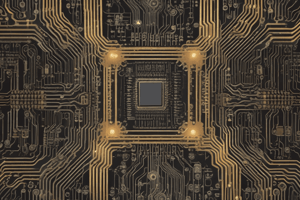Podcast
Questions and Answers
What is the primary purpose of a voltage regulating device in a power supply?
What is the primary purpose of a voltage regulating device in a power supply?
What type of power supply contains a rectifier and a filter circuit?
What type of power supply contains a rectifier and a filter circuit?
What is the effect of a 5% increase in input AC voltage on the DC output voltage of an ordinary DC power supply?
What is the effect of a 5% increase in input AC voltage on the DC output voltage of an ordinary DC power supply?
What is the purpose of the filter circuit in a DC power supply?
What is the purpose of the filter circuit in a DC power supply?
Signup and view all the answers
What is the main drawback of an ordinary DC power supply?
What is the main drawback of an ordinary DC power supply?
Signup and view all the answers
What is the reason for the output voltage decrease as the load current increases?
What is the reason for the output voltage decrease as the load current increases?
Signup and view all the answers
What is the primary function of a regulated power supply?
What is the primary function of a regulated power supply?
Signup and view all the answers
What is the purpose of the capacitor filter in a regulated power supply?
What is the purpose of the capacitor filter in a regulated power supply?
Signup and view all the answers
What is the primary function of the zener voltage regulator in a regulated power supply?
What is the primary function of the zener voltage regulator in a regulated power supply?
Signup and view all the answers
What is the benefit of using a regulated power supply over an ordinary power supply?
What is the benefit of using a regulated power supply over an ordinary power supply?
Signup and view all the answers
Study Notes
Introduction to Electronic Engineering
- In electronic circuits, a source of d.c. power is required, which is usually obtained from commercial a.c. lines using a rectifier-filter system.
- Batteries are not commonly used due to their high cost and need for frequent replacement.
Ordinary D.C. Power Supply
- Consists of a rectifier and a filter circuit.
- Rectifier output is pulsating d.c. with a.c. components.
- Filter circuit removes a.c. components to produce steady d.c. voltage across the load.
- Drawbacks of ordinary d.c. power supply:
- Output voltage changes with input a.c. voltage.
- Output voltage decreases as load current increases due to voltage drop in transformer windings, rectifier, and filter circuit.
Regulated Power Supply
- Maintains output voltage constant despite a.c. mains fluctuations or load variations.
- Consists of an ordinary power supply and a voltage regulating device.
- Output voltage remains constant with changes in load current or input a.c. voltage.
- Examples of regulated power supplies include:
- Zener diode voltage regulator
- Transistor series regulator
- OP-AMP voltage regulators
Zener Diode Voltage Regulator
- Combines three circuits: bridge rectifier, capacitor filter, and zener voltage regulator.
- Bridge rectifier converts a.c. voltage to pulsating voltage.
- Capacitor filter reduces pulsations in rectifier output voltage.
- Zener voltage regulator reduces variations in filtered output voltage and keeps output voltage nearly constant.
- Waveforms at various stages of regulated power supply:
- Pulsating voltage (point Q) from bridge rectifier.
- Filtered output voltage (point R) from capacitor filter.
- Regulated output voltage (Vout) from zener voltage regulator.
Studying That Suits You
Use AI to generate personalized quizzes and flashcards to suit your learning preferences.
Description
This quiz covers the basics of electronic engineering, focusing on voltage regulators, including Zener diode regulators, transistor series regulators, and OP-AMP voltage regulators.





